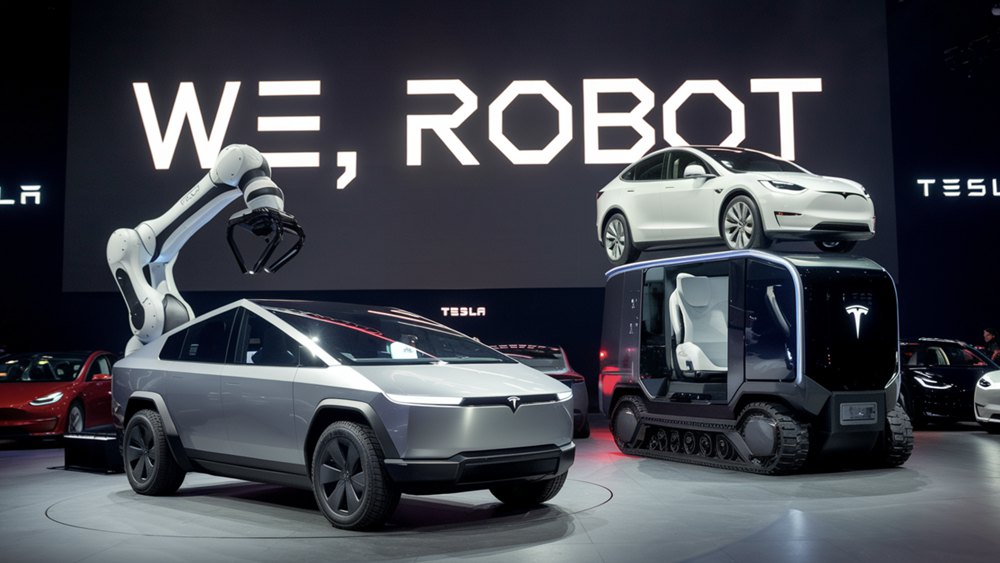Tesla’s “We, Robot” Revolution: Unveiling the Cybercab, Robovan, and Tesla Bot

The Cybercab: A New Era of Autonomous Transportation
Design and Features
The Tesla Cybercab is a purpose-built autonomous vehicle designed to redefine urban mobility. With its sleek, futuristic design inspired by the Cybertruck, the Cybercab features upward-opening butterfly doors and a minimalist interior tailored for two passengers. Notably, the vehicle lacks traditional controls such as a steering wheel and pedals, emphasizing its fully autonomous nature. This design choice aligns with Tesla’s vision of a driverless future, where passengers can engage in other activities while traveling.
Technological Advancements
The Cybercab is equipped with Tesla’s Full Self-Driving (FSD) technology, which relies solely on cameras and machine learning algorithms for navigation. This approach, while innovative, has drawn criticism for its lack of redundant safety systems like radar and lidar, which are used by competitors such as Waymo and Cruise. Despite these concerns, Musk claims that the Cybercab will be “10-20 times safer than human-driven cars,” with an operational cost of approximately $0.20 per mile, significantly lower than traditional taxis and public transport.
Production Timeline and Pricing
Tesla plans to begin production of the Cybercab in 2026, with a projected price below $30,000. This competitive pricing aims to make the Cybercab accessible to a broader audience, particularly for fleet use in ride-sharing services. However, regulatory approval remains a significant hurdle due to the vehicle’s unconventional design and lack of traditional driving controls. Tesla’s ability to navigate these challenges will be crucial in determining the Cybercab’s success in the market.
Expanding the Autonomous Fleet: The Robovan and Tesla Bot
The Robovan: A Versatile Autonomous Solution
In addition to the Cybercab, Musk unveiled the Robovan, a larger autonomous vehicle capable of transporting up to 20 people or goods. The Robovan’s design features a sleek, futuristic aesthetic with large glass sliding doors, making it adaptable for various uses, including mass transit and cargo transport. Musk emphasized the Robovan’s potential to reduce travel costs to as low as $0.05 to $0.10 per mile, further highlighting Tesla’s commitment to affordable autonomous transportation.
The Tesla Bot: A Glimpse into the Future of Robotics
The event also showcased the Tesla Bot, a humanoid robot designed to assist with household tasks and engage in social settings. Priced between $20,000 and $30,000, the Tesla Bot represents Tesla’s foray into the robotics industry, with potential applications ranging from personal assistance to industrial automation. During the event, the Tesla Bot demonstrated its capabilities by performing tasks such as serving drinks and interacting with attendees, underscoring Tesla’s vision of integrating robotics into everyday life.
Challenges and Skepticism: Navigating the Road Ahead
Technological and Safety Concerns
Despite the excitement surrounding Tesla’s announcements, skepticism remains regarding the viability of its autonomous technology. Critics point to Tesla’s reliance on a camera-only approach, which lacks the redundancy of systems used by competitors. This “black box” method poses challenges in handling rare driving scenarios and identifying system failures. Furthermore, Tesla’s FSD technology has faced scrutiny for safety issues, including “phantom braking” incidents, which have led to ongoing investigations by the National Highway Traffic Safety Administration (NHTSA).
Regulatory and Market Challenges
Regulatory approval is another significant challenge for Tesla’s autonomous vehicles. The absence of federal laws governing self-driving technology creates a complex landscape for companies like Tesla, which must navigate varying state regulations. Additionally, the market readiness of autonomous vehicles remains uncertain, with consumer surveys indicating that robotaxis are still perceived as a novelty rather than a practical transportation solution. Tesla’s ability to address these challenges will be critical in determining the success of its autonomous fleet.
The Business Model: Revolutionizing Urban Mobility
Dual Model Approach
Tesla’s business model for the Cybercab and Robovan envisions a dual approach, where Tesla operates its own fleet of autonomous vehicles while allowing Tesla owners to deploy their vehicles in a ride-sharing network. This model aims to generate income for vehicle owners, similar to platforms like Uber and Lyft, with Tesla taking a commission on rides. However, the profitability of this model remains uncertain, given the high operational costs associated with autonomous vehicles, including safety, computing power, and insurance liabilities.
Market Potential and Revenue Projections
Despite these challenges, analysts project significant revenue potential for Tesla’s robotaxi business. Ark Invest estimates that by 2029, the robotaxi market could generate $750 billion annually, vastly increasing Tesla’s market capitalization. However, widespread adoption of autonomous vehicles is expected to take time, with some estimates suggesting it could take until 2035 for the technology to become mainstream. Tesla’s ability to navigate regulatory hurdles and technological challenges will be crucial in realizing this potential.
Conclusion: A Pivotal Moment for Tesla
Tesla’s unveiling of the Cybercab, Robovan, and Tesla Bot marks a pivotal moment in the company’s pursuit of autonomous driving technology. While the potential impact on urban transportation is significant, Tesla faces numerous challenges in achieving its vision. Technological and safety concerns, regulatory hurdles, and market readiness all pose significant obstacles that Tesla must overcome to succeed in the autonomous vehicle market.
Despite these challenges, Tesla’s ambitious plans underscore its commitment to revolutionizing urban mobility. The company’s innovative approach to autonomous technology, combined with its competitive pricing strategy, positions Tesla as a key player in the future of transportation. As Tesla continues to push the boundaries of what’s possible, the coming years will be critical in determining the success of its autonomous fleet and its impact on the automotive industry.
Send us a Message
Contact us
Contact us today to learn more about Kavout's products or services.

